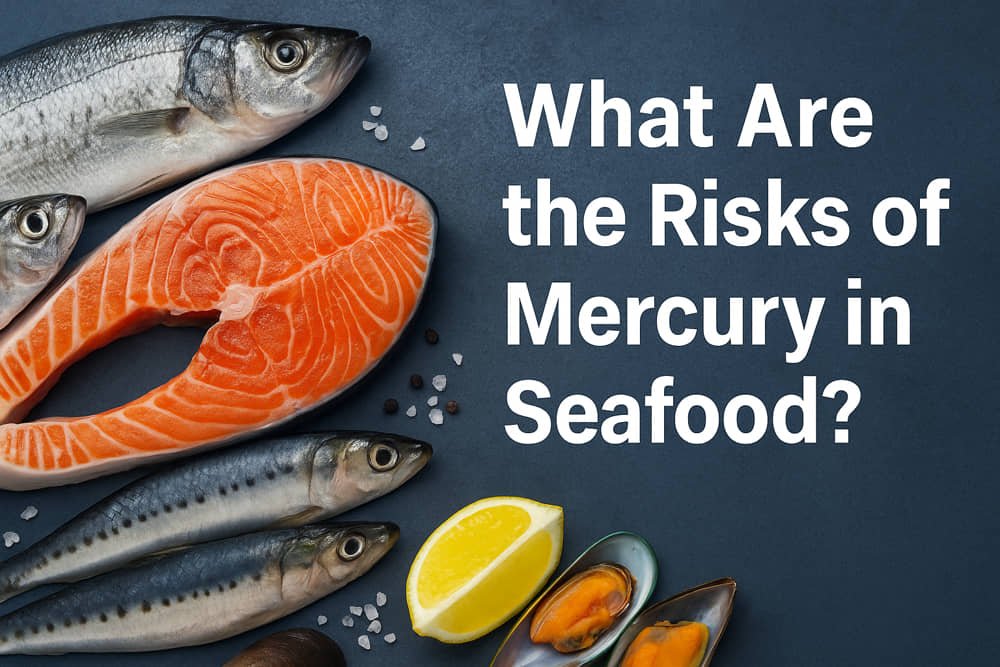Mercury contamination in seafood has become a significant public health concern in recent decades. As industrial pollution increases and marine ecosystems face new environmental pressures, the risk of mercury accumulation in fish and shellfish is rising. This issue is not confined to specific regions but is a global problem impacting both developed and developing countries. Consumers who enjoy seafood for its nutritional benefits, especially its rich content of omega-3 fatty acids, often overlook the hidden danger of mercury exposure. Understanding how mercury enters the food chain and which seafood species pose the highest risks is essential for making informed dietary choices. In this guide, you will find clear, science-backed answers to the most critical questions about mercury in seafood and how to manage your exposure without sacrificing the health benefits of your favorite meals.
Contents
- 1 What Is Mercury and Why Is It Found in Seafood?
- 2 Which Seafood Species Have the Highest Levels of Mercury?
- 3 How Does Mercury Exposure Affect Human Health?
- 4 How Much Mercury Is Considered Safe for Consumption?
- 5 Which Groups of People Are Most Vulnerable to Mercury Poisoning?
- 6 Can Cooking or Preparation Methods Reduce Mercury Levels in Seafood?
- 7 What Are Safer Seafood Choices with Low Mercury Levels?
- 8 How Can You Reduce Mercury Exposure Without Giving Up Seafood?
- 9 Should You Consider Mercury Detox Supplements or Remedies?
- 10 Is There a Way to Monitor Mercury Levels in Your Body?
- 11 How Can Mercury Exposure Impact Global Food Security?
- 12 Can You Completely Eliminate Mercury from Seafood?
What Is Mercury and Why Is It Found in Seafood?
Mercury is a naturally occurring heavy metal found in the earth’s crust. However, most mercury contamination in seafood results from industrial activities such as coal burning, mining, and chemical manufacturing. These processes release inorganic mercury into the atmosphere, which eventually settles into oceans and waterways.
In aquatic environments, microorganisms convert inorganic mercury into methylmercury—a highly toxic form that accumulates in fish and shellfish. Methylmercury binds tightly to proteins in fish muscle tissue, making it impossible to remove through cooking or cleaning. This bioaccumulation process is particularly concerning because it leads to higher mercury concentrations as you move up the marine food chain.
How Does Mercury Enter Marine Ecosystems?
Mercury primarily enters marine ecosystems through atmospheric deposition and direct industrial discharge. When mercury particles fall into the ocean, they settle into sediment layers where bacteria convert them into methylmercury. This toxic compound is absorbed by plankton and small organisms, which are then consumed by larger fish.
This chain reaction explains why even remote ocean areas contain fish with elevated mercury levels. According to the U.S. Environmental Protection Agency (EPA), atmospheric deposition accounts for roughly 70% of mercury found in oceans, making it a global pollution issue rather than a localized one.
Which Types of Mercury Are Present in Seafood? (Elemental, Methylmercury, etc.)
Seafood primarily contains methylmercury, the most toxic and bioavailable form of mercury to humans. While elemental mercury and inorganic mercury compounds exist in the environment, they are rarely found in significant amounts within seafood.
Methylmercury is highly absorbed in the human digestive system, with nearly 95% absorption efficiency once ingested. This efficiency makes even small quantities of contaminated seafood a health concern, especially for vulnerable populations such as pregnant women and young children.
Which Seafood Species Have the Highest Levels of Mercury?
Mercury levels vary significantly among seafood species, largely depending on their size, diet, and lifespan. Larger, long-living predatory fish tend to accumulate the most mercury because they consume other contaminated organisms throughout their lives—a process known as biomagnification.
Why Do Larger Predatory Fish Contain More Mercury?
Predatory fish such as shark, swordfish, king mackerel, and certain types of tuna are at the top of the food chain. These species consume smaller fish that already contain mercury, leading to higher cumulative mercury levels in their tissues over time.
For example, a single serving of swordfish can contain over 1.0 ppm (parts per million) of mercury, which is five times higher than the FDA’s action limit for safe consumption. Regularly eating these fish increases the risk of mercury poisoning, especially in populations with lower body weights or compromised health conditions.
What Are the Top 10 High-Mercury Fish to Avoid?
- Shark
- Swordfish
- King Mackerel
- Tilefish (Gulf of Mexico)
- Bigeye Tuna
- Marlin
- Orange Roughy
- Ahi Tuna (Yellowfin)
- Chilean Sea Bass
- Bluefin Tuna
For safer alternatives, choose low-mercury seafood options like salmon, sardines, and trout. If you’re also concerned about safe seafood consumption practices, you may want to explore our guide on Is It Safe to Eat Raw Shellfish and Sushi?.
How Does Mercury Exposure Affect Human Health?
Mercury exposure through seafood consumption poses serious health risks because methylmercury affects multiple systems in the human body. Once absorbed, it crosses the blood-brain barrier and accumulates in vital organs, including the brain, heart, kidneys, and liver. The effects are most pronounced with long-term exposure, even at low doses. Vulnerable groups such as pregnant women, infants, and people with compromised health conditions face the highest risks.
What Are the Neurological Risks of Mercury Consumption?
Methylmercury is classified as a potent neurotoxin. It interferes with normal brain development and nerve function, making neurological risks the most critical concern. In adults, symptoms of mercury toxicity include memory loss, mood disturbances, numbness or tingling in the extremities, and muscle weakness.
For developing fetuses and young children, the consequences are even more severe. Prenatal exposure to mercury is linked to cognitive impairments, delayed speech and motor development, and reduced IQ scores. According to the World Health Organization (WHO), even low-level exposure during pregnancy can permanently affect a child’s brain development.
Can Mercury Exposure Cause Cardiovascular Problems?
Yes, several studies have established a link between mercury exposure and cardiovascular diseases. Methylmercury promotes oxidative stress and damages the endothelial lining of blood vessels, leading to arterial stiffness and hypertension.
A large-scale study published in the New England Journal of Medicine found that individuals with high mercury levels in their blood had a significantly higher risk of myocardial infarction (heart attack). Additionally, mercury can disrupt heart rate variability, increasing the risk of arrhythmias and sudden cardiac events.
How Does Mercury Impact Pregnant Women and Developing Fetuses?
Pregnant women are particularly vulnerable to the harmful effects of mercury due to its ability to cross the placental barrier. Methylmercury concentrates in the developing fetus’s tissues, especially in the brain and nervous system.
High mercury exposure during pregnancy increases the risk of premature birth, low birth weight, and developmental delays. The U.S. Food and Drug Administration (FDA) and Environmental Protection Agency (EPA) advise pregnant women to limit their mercury intake to no more than 8–12 ounces of low-mercury seafood per week to minimize potential risks.
How Much Mercury Is Considered Safe for Consumption?
The safety threshold for mercury consumption varies by regulatory body but is generally very conservative due to mercury’s toxicity and cumulative effects. Understanding these limits helps individuals make informed decisions about seafood consumption without unnecessary health risks.
What Are the FDA and EPA Recommended Mercury Limits?
The FDA has set an action limit of 1.0 parts per million (ppm) of methylmercury in commercial fish. However, this does not mean all fish under this limit are safe for frequent consumption. The EPA’s more stringent guideline recommends a maximum daily intake of 0.1 micrograms of mercury per kilogram of body weight.
For a person weighing 70 kg (about 154 lbs), this equates to 7 micrograms of mercury per day. Consuming one 170-gram (6-ounce) serving of a high-mercury fish like swordfish can easily exceed this limit.
How Can You Calculate Your Personal Mercury Exposure from Seafood?
To calculate your mercury exposure:
- Identify the mercury concentration of the seafood (in ppm).
- Multiply by the portion size consumed (in grams).
- Compare this value to your safe daily limit.
For example, eating 200 grams of bigeye tuna (average 0.689 ppm mercury) results in 137.8 micrograms of mercury intake, nearly 20 times the EPA’s recommended daily limit for a 70-kg adult.
You can also use online mercury calculators from trusted sources such as the FDA and EPA to simplify this process.
Which Groups of People Are Most Vulnerable to Mercury Poisoning?
While mercury affects everyone to some degree, certain populations are at a significantly higher risk of toxicity due to their physiological conditions or consumption habits.
Why Should Children and Pregnant Women Limit Mercury Intake?
Children and unborn babies are highly susceptible because their nervous systems are still developing. Mercury exposure during critical growth stages can cause irreversible damage, including cognitive deficits and motor skill impairments.
Health organizations worldwide, including the Centers for Disease Control and Prevention (CDC) and the World Health Organization (WHO), recommend that pregnant women and children avoid high-mercury fish altogether and opt for safer alternatives like salmon, sardines, and cod.
Are There Health Risks for Frequent Seafood Consumers?
Yes, individuals who regularly consume large quantities of seafood—such as coastal communities, athletes, or people following pescatarian diets—are more likely to experience chronic mercury exposure.
Symptoms of long-term mercury accumulation include chronic fatigue, joint pain, tremors, depression, and in severe cases, kidney dysfunction. If you are a frequent seafood consumer, regular monitoring of mercury levels through blood or hair testing is advised to ensure levels remain within a safe range.
Can Cooking or Preparation Methods Reduce Mercury Levels in Seafood?
Many people believe that cooking techniques can minimize mercury content in seafood. However, this is a misconception. Mercury, especially in the form of methylmercury, binds tightly to muscle tissues and cannot be removed through cooking, freezing, or cleaning processes.
Whether seafood is grilled, boiled, or fried, the mercury content remains largely unchanged. The only way to effectively reduce mercury exposure is to select fish species known for lower mercury concentrations and to limit the intake of high-risk seafood.
Does Grilling, Boiling, or Frying Affect Mercury Content?
No, these cooking methods do not significantly affect mercury levels in seafood. Methylmercury is stable at the temperatures used in typical cooking processes. Even extreme heat does not break down or eliminate the mercury present in fish tissues.
While certain cooking methods like boiling or steaming may reduce fat content and remove other harmful compounds, they have no measurable impact on mercury. This is why dietary guidelines emphasize choosing low-mercury fish rather than relying on preparation methods to make seafood safer.
What Are Safer Seafood Choices with Low Mercury Levels?
Opting for seafood with naturally low mercury levels is the most effective strategy to enjoy the health benefits of fish while minimizing mercury exposure. Many small, short-lived fish species accumulate far less mercury compared to larger, predatory species.
Which Fish Are Recommended for Regular Consumption? (e.g., Salmon, Sardines)
The following fish are considered low in mercury and are safe for regular consumption:
- Salmon (especially wild-caught)
- Sardines
- Trout
- Tilapia
- Herring
- Anchovies
- Catfish
- Pollock
These species are also rich in essential nutrients, including omega-3 fatty acids, vitamin D, and high-quality protein. According to the FDA and EPA guidelines, it is safe to consume up to 2–3 servings of these low-mercury fish per week, even for pregnant women and children.
How Can You Balance Omega-3 Intake with Mercury Risks?
To balance the need for omega-3 fatty acids while minimizing mercury risks:
- Prioritize Low-Mercury, High Omega-3 Fish:
Salmon, sardines, and trout are excellent choices that deliver high omega-3 content without significant mercury exposure. - Include Plant-Based Omega-3 Sources:
Flaxseeds, chia seeds, and walnuts are rich in alpha-linolenic acid (ALA), a plant-based omega-3. Although ALA conversion to DHA and EPA is limited, it still contributes to overall omega-3 intake. - Consider Purified Omega-3 Supplements:
High-quality fish oil supplements undergo purification processes that remove mercury and other contaminants. This provides a safe alternative for those concerned about mercury levels in seafood.
How Can You Reduce Mercury Exposure Without Giving Up Seafood?
Eliminating seafood entirely is unnecessary and may even deprive your body of essential nutrients. Instead, adopt strategies to minimize mercury exposure while maintaining the health benefits of seafood.
What Are Effective Meal Planning Strategies for Safe Seafood Consumption?
- Diversify Your Seafood Choices: Rotate between low-mercury fish and shellfish to avoid overexposure from any single source.
- Follow the “Best Choices” List from the FDA: Choose seafood species that consistently test low for mercury.
- Limit Portion Sizes of Higher-Mercury Fish: If you occasionally consume fish like tuna, opt for smaller portions and space out meals over several weeks.
- Stay Informed Through Official Guidelines: Refer to updated recommendations from the FDA and EPA to keep your seafood consumption within safe limits.
Should You Consider Mercury Detox Supplements or Remedies?
There is limited scientific evidence supporting the effectiveness of mercury detox supplements. Common ingredients like chlorella, cilantro, and activated charcoal are often marketed for this purpose, but clinical studies have not confirmed their efficacy for removing methylmercury from human tissues.
If you suspect mercury toxicity, it is critical to consult a healthcare professional. Chelation therapy is the only medically recognized treatment for mercury poisoning, and it should only be administered under medical supervision.
Should You Consider Mercury Detox Supplements or Remedies?
While the idea of detoxifying the body from heavy metals sounds appealing, most over-the-counter mercury detox supplements lack scientific validation. Products containing chlorella, cilantro extract, selenium, and activated charcoal are often promoted for mercury removal. However, current clinical research does not support their effectiveness in eliminating methylmercury from human tissues.
The human body naturally expels small amounts of mercury over time through the kidneys and liver. For individuals experiencing significant mercury toxicity, the only medically approved treatment is chelation therapy, which uses agents like dimercaptosuccinic acid (DMSA) under strict medical supervision. This treatment is reserved for confirmed cases of mercury poisoning and is not recommended for casual detoxification purposes.
Key Takeaway: Rely on safer seafood choices and proper dietary planning rather than unproven supplements for mercury management. Always consult a healthcare professional before considering any detox treatments.
Is There a Way to Monitor Mercury Levels in Your Body?
Yes, if you are concerned about long-term exposure to mercury, medical testing can assess your body’s mercury levels. These tests help determine whether lifestyle adjustments or medical interventions are necessary.
What Types of Mercury Testing Are Available?
- Blood Tests:
Blood mercury levels reflect recent exposure, typically within the last few days or weeks. This method is commonly used for individuals who have consumed large amounts of high-mercury seafood recently. - Hair Analysis:
Mercury accumulates in hair over time, making it a reliable indicator of long-term exposure. Hair testing can reveal mercury intake patterns over several months, helping identify chronic exposure risks. - Urine Tests:
Although urine tests are less effective for methylmercury (the form found in seafood), they are sometimes used in combination with other methods to assess overall mercury exposure.
Health organizations recommend that people at higher risk—such as pregnant women, children, and frequent seafood consumers—consider periodic mercury testing, especially if their diets regularly include large predatory fish.
How Can Mercury Exposure Impact Global Food Security?
Mercury contamination is not only a health concern for individuals but also a growing threat to global food security. As industrial pollution continues to rise, more marine ecosystems become compromised, reducing the availability of safe and sustainable seafood sources.
What Are the Long-Term Effects on Fisheries and Coastal Economies?
- Declining Fish Stocks:
Elevated mercury levels in popular commercial species lead to fishing restrictions and reduced catch quotas. This negatively impacts local economies reliant on seafood exports and fishing industries. - Reduced Consumer Confidence:
As awareness of mercury contamination grows, consumer demand for certain seafood products declines. This leads to significant financial losses for communities dependent on fisheries. - Environmental Chain Reactions:
Mercury pollution contributes to the broader problem of ocean degradation. Combined with overfishing and habitat destruction, it exacerbates the collapse of marine ecosystems critical to sustaining the global food supply.
Efforts to reduce industrial mercury emissions and promote sustainable fishing practices are essential to safeguard both human health and the planet’s future seafood resources.
Can You Completely Eliminate Mercury from Seafood?
Completely eliminating mercury from seafood is not currently possible due to its persistent presence in marine environments. Even low-mercury species contain trace amounts of this heavy metal, but these levels are often negligible and well below established safety thresholds when consumed in moderation.
The most practical approach is not elimination but risk mitigation. By carefully selecting seafood species with lower mercury content and managing portion sizes, consumers can enjoy the nutritional benefits of seafood while keeping mercury exposure within safe limits.
Focus on nutrient-dense, low-mercury seafood options such as salmon, sardines, trout, and herring. Prioritize variety and moderation, especially for vulnerable groups like pregnant women or frequent seafood consumers. Stay informed with official mercury advisories and consider periodic health monitoring if seafood plays a significant role in your diet.



